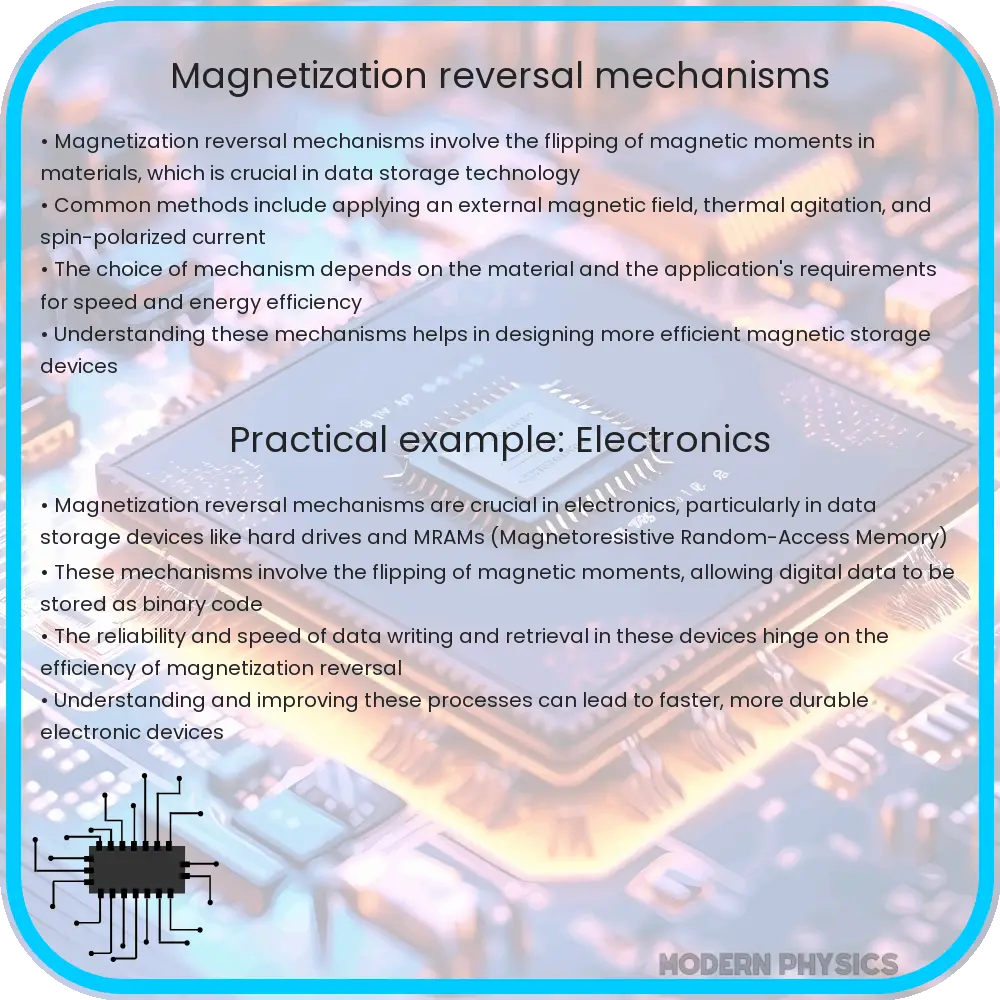Explore the fascinating world of magnetization reversal, its mechanisms, technological impact, and future in data storage and spintronics.

Magnetization Reversal: An Overview
Magnetization reversal, a fundamental process in physics and materials science, refers to the switching of the magnetic moment direction in a magnetic material. This phenomenon is pivotal in various technological applications, notably in data storage and magnetic sensors.
The Physics Behind Magnetization Reversal
At its core, magnetization reversal involves the alignment of atomic magnetic moments, which are akin to tiny magnets, in a material. In ferromagnetic materials, these moments are aligned in the same direction under normal circumstances. The process of reversing their direction involves overcoming the coercivity, the resistance of a magnetic material to changes in its magnetization.
Process of Magnetization Reversal
The reversal can be induced by external magnetic fields, temperature changes, or stress. There are two primary mechanisms:
- Coherent Rotation: In this mode, all magnetic moments rotate simultaneously, maintaining their parallel alignment throughout the process. This mechanism is common in small, single-domain particles.
- Domain Wall Motion: Larger, multi-domain materials undergo reversal through the movement of domain walls, the boundaries separating regions with different magnetic orientations. Magnetic moments flip as the wall moves across the material.
Impact of Magnetization Reversal
Magnetization reversal is integral to the functioning of modern data storage devices, such as hard disk drives (HDDs). In HDDs, data is stored in the form of magnetic bits on a disk. Writing data involves reversing the magnetization of these bits, a process governed by the principles of magnetization reversal.
Moreover, understanding and controlling this process is crucial in developing advanced magnetic materials with specific properties, such as high-density storage media and sensitive magnetic sensors. Research in this field continually pushes the boundaries of data storage technology, enabling the creation of devices with greater storage capacity and faster access times.
Recent advancements in nanotechnology have further accentuated the significance of magnetization reversal. Nanoscale magnetic materials exhibit unique reversal behaviors due to their reduced dimensions and increased surface-to-volume ratio. These behaviors open new avenues in the miniaturization and performance enhancement of magnetic devices.
The study of magnetization reversal also has implications in other fields such as medicine, where magnetic nanoparticles are used for targeted drug delivery and magnetic resonance imaging (MRI).
Technological Implications and Future Directions
The manipulation of magnetization reversal is a cornerstone in the development of spintronics, a technology that exploits the intrinsic spin of electrons along with their fundamental electronic charge. Spintronic devices, which include spin valves and magnetic tunnel junctions, offer enhanced performance for memory and logic applications. The efficiency of these devices hinges on precise control over magnetization reversal processes.
Furthermore, the exploration of magnetization reversal in novel materials, such as rare-earth free magnets and topological insulators, is opening up new possibilities. These materials promise to deliver improved performance with reduced environmental impact, addressing both technological and sustainability concerns.
Challenges in Magnetization Reversal Research
Despite significant advancements, challenges persist in the study of magnetization reversal. Understanding the dynamics at the nanoscale, particularly in complex materials and under extreme conditions, remains a frontier in research. Additionally, the quest for faster, more efficient reversal methods is critical for the progression of high-speed computing and data storage technologies.
Another challenge lies in the integration of magnetic materials with other systems, like semiconductors, for creating hybrid devices. This integration requires overcoming compatibility issues between different materials and optimizing their collective properties.
Conclusion
Magnetization reversal stands at the intersection of fundamental physics and cutting-edge technology. Its study not only deepens our understanding of magnetic phenomena but also drives innovation in data storage, computing, and beyond. As we continue to unravel the complexities of this process, we can expect to see a new generation of devices and technologies emerge, offering faster, more efficient, and environmentally friendly solutions. The future of magnetization reversal research is poised to significantly influence various scientific and industrial domains, making it an exciting and crucial area of ongoing scientific inquiry.
